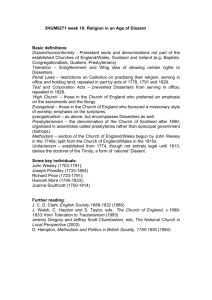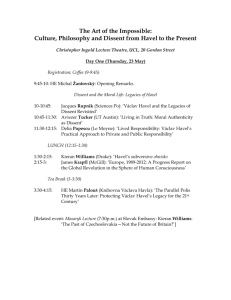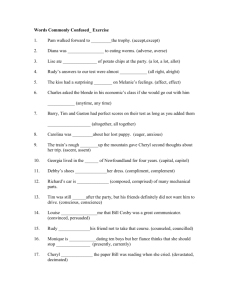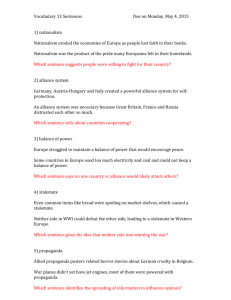Document
advertisement
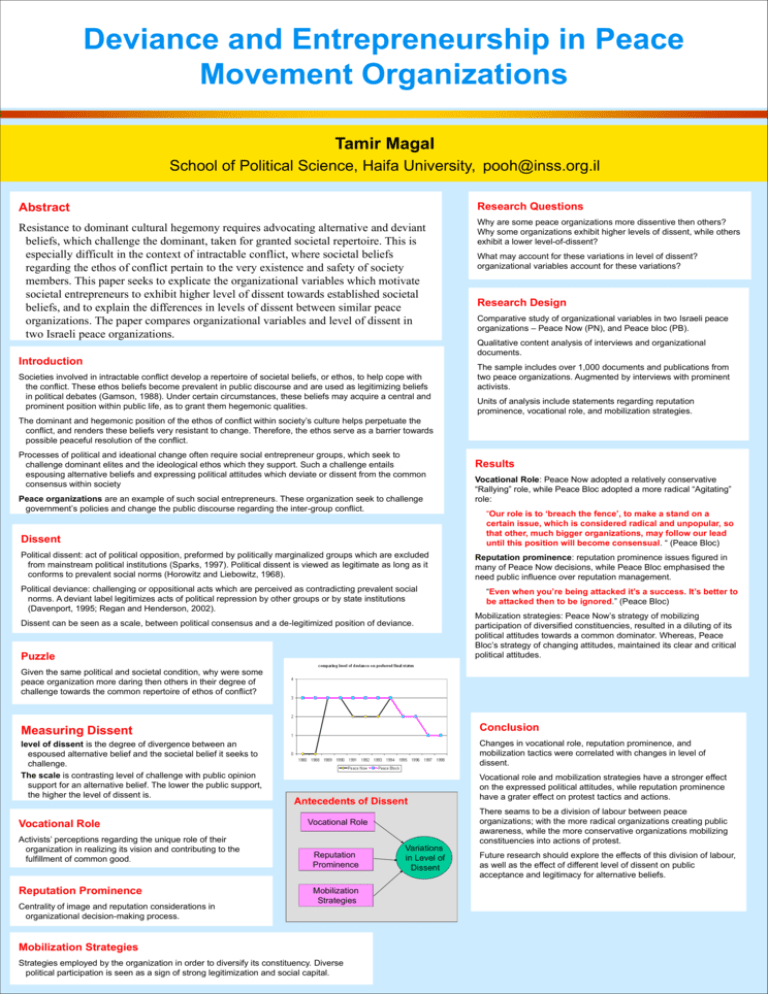
Deviance and Entrepreneurship in Peace Movement Organizations Tamir Magal School of Political Science, Haifa University, pooh@inss.org.il Research Questions Abstract Resistance to dominant cultural hegemony requires advocating alternative and deviant beliefs, which challenge the dominant, taken for granted societal repertoire. This is especially difficult in the context of intractable conflict, where societal beliefs regarding the ethos of conflict pertain to the very existence and safety of society members. This paper seeks to explicate the organizational variables which motivate societal entrepreneurs to exhibit higher level of dissent towards established societal beliefs, and to explain the differences in levels of dissent between similar peace organizations. The paper compares organizational variables and level of dissent in two Israeli peace organizations. Introduction Societies involved in intractable conflict develop a repertoire of societal beliefs, or ethos, to help cope with the conflict. These ethos beliefs become prevalent in public discourse and are used as legitimizing beliefs in political debates (Gamson, 1988). Under certain circumstances, these beliefs may acquire a central and prominent position within public life, as to grant them hegemonic qualities. Why are some peace organizations more dissentive then others? Why some organizations exhibit higher levels of dissent, while others exhibit a lower level-of-dissent? What may account for these variations in level of dissent? organizational variables account for these variations? Research Design Comparative study of organizational variables in two Israeli peace organizations – Peace Now (PN), and Peace bloc (PB). Qualitative content analysis of interviews and organizational documents. The sample includes over 1,000 documents and publications from two peace organizations. Augmented by interviews with prominent activists. Units of analysis include statements regarding reputation prominence, vocational role, and mobilization strategies. The dominant and hegemonic position of the ethos of conflict within society’s culture helps perpetuate the conflict, and renders these beliefs very resistant to change. Therefore, the ethos serve as a barrier towards possible peaceful resolution of the conflict. Processes of political and ideational change often require social entrepreneur groups, which seek to challenge dominant elites and the ideological ethos which they support. Such a challenge entails espousing alternative beliefs and expressing political attitudes which deviate or dissent from the common consensus within society Peace organizations are an example of such social entrepreneurs. These organization seek to challenge government’s policies and change the public discourse regarding the inter-group conflict. Dissent Political dissent: act of political opposition, preformed by politically marginalized groups which are excluded from mainstream political institutions (Sparks, 1997). Political dissent is viewed as legitimate as long as it conforms to prevalent social norms (Horowitz and Liebowitz, 1968). Political deviance: challenging or oppositional acts which are perceived as contradicting prevalent social norms. A deviant label legitimizes acts of political repression by other groups or by state institutions (Davenport, 1995; Regan and Henderson, 2002). Dissent can be seen as a scale, between political consensus and a de-legitimized position of deviance. Puzzle Results Vocational Role: Peace Now adopted a relatively conservative “Rallying” role, while Peace Bloc adopted a more radical “Agitating” role: “Our role is to ‘breach the fence’, to make a stand on a certain issue, which is considered radical and unpopular, so that other, much bigger organizations, may follow our lead until this position will become consensual. “ (Peace Bloc) Reputation prominence: reputation prominence issues figured in many of Peace Now decisions, while Peace Bloc emphasised the need public influence over reputation management. “Even when you’re being attacked it’s a success. It’s better to be attacked then to be ignored.” (Peace Bloc) Mobilization strategies: Peace Now’s strategy of mobilizing participation of diversified constituencies, resulted in a diluting of its political attitudes towards a common dominator. Whereas, Peace Bloc’s strategy of changing attitudes, maintained its clear and critical political attitudes. Given the same political and societal condition, why were some peace organization more daring then others in their degree of challenge towards the common repertoire of ethos of conflict? Measuring Dissent Conclusion level of dissent is the degree of divergence between an espoused alternative belief and the societal belief it seeks to challenge. The scale is contrasting level of challenge with public opinion support for an alternative belief. The lower the public support, the higher the level of dissent is. Changes in vocational role, reputation prominence, and mobilization tactics were correlated with changes in level of dissent. Vocational Role Activists’ perceptions regarding the unique role of their organization in realizing its vision and contributing to the fulfillment of common good. Reputation Prominence Centrality of image and reputation considerations in organizational decision-making process. Antecedents of Dissent There seams to be a division of labour between peace organizations; with the more radical organizations creating public awareness, while the more conservative organizations mobilizing constituencies into actions of protest. Vocational Role Reputation Prominence Mobilization Strategies Mobilization Strategies Strategies employed by the organization in order to diversify its constituency. Diverse political participation is seen as a sign of strong legitimization and social capital. Vocational role and mobilization strategies have a stronger effect on the expressed political attitudes, while reputation prominence have a grater effect on protest tactics and actions. Variations in Level of Dissent Future research should explore the effects of this division of labour, as well as the effect of different level of dissent on public acceptance and legitimacy for alternative beliefs.


